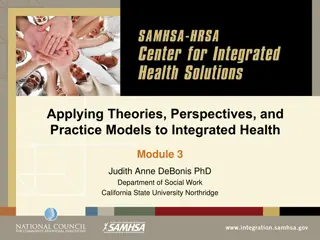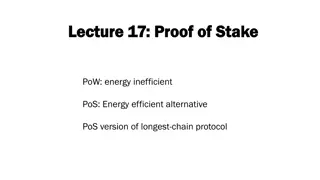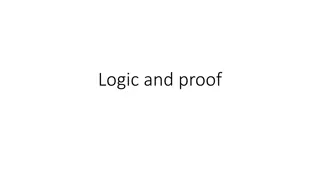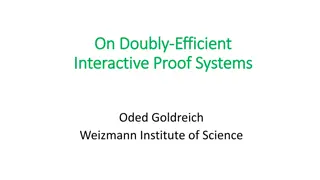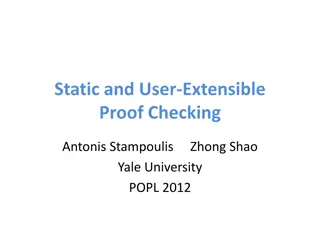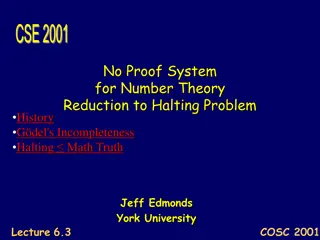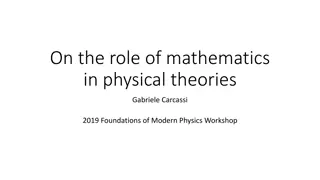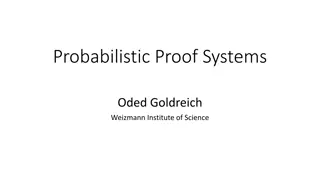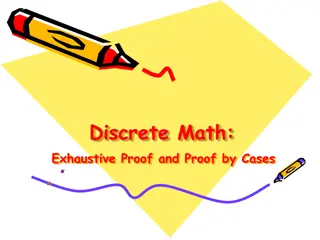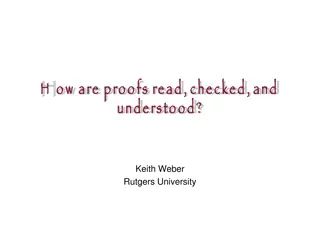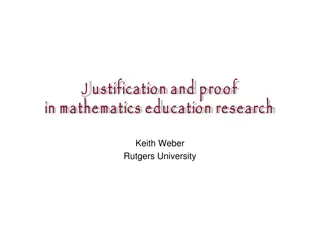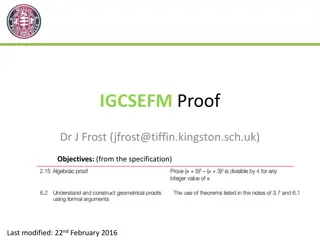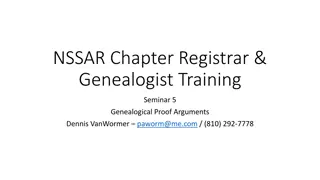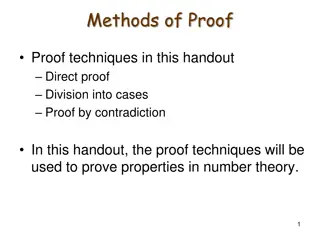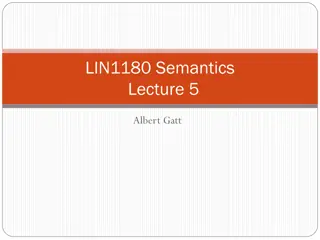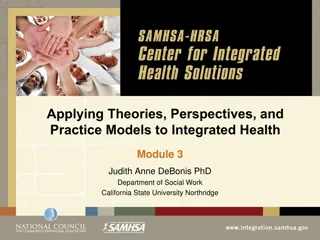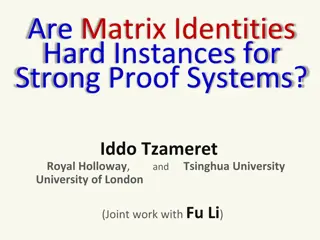Evolution of Mathematical Theories and Proof Systems
Development of mathematical theories such as model theory, proof theory, set theory, recursion theory, and computational complexity is discussed, starting from historical perspectives with Dedekind and Peano to Godel's theorems, recursion theory's golden age in the 1930s, and advancements in proof theory through key figures like Gentzen and Henkin. The emergence of foundational concepts like the Church-Turing thesis and the Completeness Theorem are highlighted, shaping the landscape of modern mathematical logic.
Download Presentation

Please find below an Image/Link to download the presentation.
The content on the website is provided AS IS for your information and personal use only. It may not be sold, licensed, or shared on other websites without obtaining consent from the author. Download presentation by click this link. If you encounter any issues during the download, it is possible that the publisher has removed the file from their server.
E N D
Presentation Transcript
E Pluribus Enum Emergence of MoPA Model Theory, Proof Theory, Set Theory, Recursion Theory, Computational Complexity, Algebra Ken McAloon-Ryniak
Pre-History Dedekind Peano Thought in 2ndOrder Terms, N as categorical Frege and First Order Logic Principia Mathematica, Zermelo, Zermelo- Fraenkel Set Theory all first order theories Hilbert s Program and Proof Theory Presburger Arithmetic and QE (1929) Tarski assigned it as an Master s degree project
Gdels Theorems Completeness Theorem (1930) Yields existence of non-standard models of PA but first-order PA was likely not yet formalized Incompleteness Theorems (1931) Hilbert s Program: Von Neumann and others had proved consistency of fragments of arithmetic The arithmetic of PM and related systems Not PA so can assume certain facts about number theory (e.g. Chinese Remainder Theorem?) First formulation was in terms of some finite combinatorial notions Who knows about this ? Dawson s book ? Is alluded to by Kripke and others Arithmetization, as we know it, suggested by Von Neumann Skolem s construction of non-standard models (1934) Here is (as far as I can tell) first formulation of first order PA Like an ultra-power construction
Recursion Theory 1930 s the Golden Age Herbrand-G del Recursive Functions, -calculus, Kleene s T-Predicate, ..., Turing Machines Church s Thesis (now the Church Turing Thesis fair enough because G del only began to believe the Thesis after seeing Turing s work). Kleene: The Germans had this Proof Theory and we were trying to catch up.
Proof Theory Gentzen s work (1930s, early 1940s) Brilliant, original Faithful to Hilbert s program G ttingen graduate student of Bernays, also worked with Hilbert and Weyl Poorly understood in my day A consistency proof for PA Quixotic Assigned 0to PA cool but vague His work and Sch tte s, all in German Tait, Spector, Curry, Howard, et al.
Aprs-Guerre Leon Henkin Elegant proof of the Completeness Theorem Henkin s Problem, L b s Theorem Arithmetic Completeness Theorem Order type of < in countable non-standard models + ( * + )* Tennenbaum (1959) no non-standard model with recursive operations Non-finite Axiomatizability of PA Ryll-Nardzewski (1952) Proof uses non-standard models
Infinitistic Methods (1961) Meeting in Warsaw 1959 MacDowell-Specker Theorem a classic a countable model of PA model has an elementary end extension Timeless: used by Jim Schmerl in 2006 paper on minimal end extensions Richard Montague reflection and finite axiomatizabillity Andrej Mostowski non-finite axiomatizability of theories Dana Scott constructing models is much more difficult for PA than Geometry because of quantifier changes in axioms and undecidability all this makes it difficult to show things are independent or whatever by building non-standard models. Capitalism is too strong to be overturned in time to save the environment (Deleuze, Guattari, Lyotard)
Hierarchies of Recursive Functions Reportedly G del said that a hierarchy for the Recursive Functions was an important open problem. Church and his students (e.g. Joel Robbin) worked on hierarchies of sub-recursive families of functions (1950s, 60s) Gossip: there was someone who wrote his thesis under Church but switched fields immediately after - telling Ralph Abraham that the field was boring But history will more than validate this work when MoPA starts to catch up with Proof Theory The Grzegorczyk hierarchy (1953)
1960s - Stalking Hilberts Tenth Rabin Non-standard models and the independence of the induction axiom (1961) Models of Arithmetic and Diophantine Equations (1962) Davis, Davis Putnam Robinson Almost there need for equation whose solutions exhibit exponential growth In 1970, Matisasevitch s Theorem (MDRP)
1970s The Confluence I Haim Gaifman Work on types was a big step in serious elegant Model Theory - 1970 paper Key short paper on MDRP and MoPA Key long paper: Models and types of Peano's arithmetic. Annals of Mathematical Logic, vol. 9(1976), pp. 223 306. Joram Hirshfeld s thesis: Existentially Complete and Generic Models for Arithmetic Student of Abraham Robinson Julia Knight Papers on Omitting Types and Hanf Numbers Alex Wilkie (The Open University) several papers among them On Models of Arithmetic Answers to Two Problems Raised by H. Gaifman
The Confluence II Angus MacIntyre-Harry Simmons G del's diagonalization technique and related properties of theories Harry Simmons talk in Paris: exploiting recursion theory to build models, thus giving a new life to those results Abramson-Harrington Models without indiscernibles (1976) Nice combinatorics: Nesteril R dl Theorem McAloon TAMS Completeness Theorems, Incompleteness Theorems and Models of Arithmetic (1978) e.g. MD requires all PA Ulf Schmerl s extension of L b s Theorem most useful for working with ordinal notations Reverse Mathematics (Friedman 1975) Subsystems of 2ndOrder Arithmetic Major program: Simpson et al.
The Confluence III Parikh (1971) Existence and Feasibility in Arithmetic Esenine-Volpin in background Applied by Paris later to solve a Solovay problem Cegielski paper Grigori Mints: The provably recursive funtions of 01induction are the primitive recursive functions. In Russian, Luc Pirdeni to the rescue
The Confluence IIII Complexity Theory, e.g. Ferrante,Rackoff on Presb Wainer (1972) working in the fields of the Lord at Leeds on what is now known as the Wainer Hierarchy Girard thought assigning ordinals like 0to PA was stupide So he developed a system of ordinal notations and a slow hierarchy that took 0(the Feferman-Sch tte ordinal) steps to outrun the provably recursive functions of PA Notations used dilators hard to follow
Set Theory and Manchester Work of Paris and Kirby and Kirby-Paris Think of cuts in non-standard models of PA as large cardinals strong cuts etc. Indicators expose richness of initial segments of such models Very British games where each move is a go Jeff s first true, unprovable combinatorial statement A (finite) set X is 0-dense if card(X) >= min X + 3 A set X is (n+ 1)-dense if for every 2-coloring of the 3 element subsets of X, there is an n-dense homogeneous subset Thm: For all n, there exist n-dense sets Use MacDowell-Specker (which requires all of PA) n-dense captures set theory s infinity It provides an indicator which yields strong cuts where the theorem itself must fail Equivalent to 1-Consistency of (PA + 10- truth)
Paris-Harrington and All That (Wikipedia) For any positive integers n, k, m, such that m n, one can find N with the following property: if we color each of the n-element subsets of S = {1, 2, 3,..., N} with one of k colors, then we can find a subset Y of S with at least m elements, such that all n- element subsets of Y have the same color, and the number of elements of Y is at least the smallest element of Y. Equivalent to 1-Consistency of PA Quickly published in the volume Handbook of Mathematical Logic (ed. Barwise, 1977)
Meanwhile Back in Paris Gaifman s course on types etc. (1977) Mod les de l arithm tique de Peano, Ast risque, 73, Soci t Math matique de France Even got Model Theory stalwarts Jean-Pierre Ressayre, Max Dickmann and Daniel Lascar into the mix Action Th matique Programm e (ATP) (1979-80) Model Theory and Arithmetic (LNM, 890) (1981) Peter Clote, Patrick Cegielski, Zo Chatzidakis, Anand Pillay Pascal Michel, Denis Richard, Very early paper by Peter Aczel Cherlin, Dickmann, Paris, Wilmers, Wilkie, McAloon-Ressayre Kirby-Murawski-McAloon paper (1979) Zofia Adamowicz
Onward Friedman-McAloon-Simpson A Finite Combinatorial Principle Which is Equivalent to the 1-Consistency of Predicative Analysis (1982) A combinatorial statement Poincar would not have been able to prove Shamelessly invoked 0 Friedman and Reverse Mathematics: a version of Kruskal s Theorem is not provable in ATR0 early 1980s according to Wikipedia Kanamori-McAloon (1987) Started with notes on large cardinals by Ketonen Regressive functions came from set theory No need for large finite sets
Yet Further Onward Kirby-Paris Hydra Proof as animation Goodstein s Theorem 0was explicitly needed for the original proof A great British moment OBE level
Hierarchies of Recursive Functions, revisited Ketonen-Solovay A direct proof of the Paris-Harrington Theorem Rate of growth of recursive functions Based on Wainer hierarchy Annals of Mathematics paper Realized a conjecture of Peter Aczel (in the ATP volume) on the role of 0
Recursion Theory Revisited Smorynski s papers on MoPA and recursive saturation (1980s) Direct recursion-theoretic proof of Kirby-Paris-Goodstein result by E.A.Chicon (1983) Harrington s solution of McAloon s problem: Construct a model of PA with arithmetic operations but non-arithmetic truth set Dazzling Chaim and I were trying to decipher it in Paris, I remember Dave Marker - first person to really get it Clote-McAloon Yet Two More Based on anti-basis theorems in Clote s paper in ATP analogous to Jockusch/Ramsey s Theorem/Paris-Harrington
Spill Out to Other Fields Wilkie s proof of Gromov s Theorem Groups of polynomial growth Finite by nil-potent Non-standard algebra Meeting at Brooklyn College Kirby, Mate, Wilkie, Ryniak, Presburger Arithmetic applied to Automated Reasoning (1970s already)
Spill Out, cont Complexity Theory KM: Finite Reachable Petri Nets (Containment problem is primitive recursive in the Ackermann function, uses large finite sets). KM and Mike Anshel: decision problems for HNN groups Jeff Paris notes Clote and others Ajtai s (muscular) paper with finite Borel sets Sigma11Formulae on Finite Structures Isomorphic integers of different parities in different models New proof of Furst-Sipser-SaxeTheorem on parity and circuits of bounded depth: A super-polynomial lower bound is given for the size of circuits of fixed depth computing the parity function.
Subsystems of PA Ehrenfeucht-Jensen (1976 FM) Cegielski Multiplication paper in ATP volume ([PA] and [EJ]) Paper with McAloon and Wilmers on Recursive Saturation Kept the faith: Journ es sur les Arithm tiques Faibles (JAF) Kaye, Paris, Dimitracopoulos On parameter free induction schemas, by Kaye, R. W., Paris, J.B., and Dimitracopoulos, C. The Journal of Symbolic Logic 53 (1988) 1082--97. Dimitracopoulos too kept the faith: Journ es sur les Arithm tiques Faibles (JAF) Buss Bad ass proof theory
A Place in the Sun Nice combinatorial proofs of things like the equivalence of Paris- Harrington and Kanamori-McAloon results Andreas Weiermann and others elegant fine analysis of fast functions Macho model theory Kossak, Schmerl, Lascar and others Book by Hajek and Pudlak Metamathematics of First-Order Arithmetic (1993) Book by Kossak and Schmerl The Structure of Models of Peano Arithmetic (2006) Book by Richard Kaye Models of Peano arithmetic (1991) Kotlarski s posthumous work A model-theoretic approach to proof theory (2019) The CUNY MoPA zoominar Journ es sur les l Arithm tiques Faibles
Patrick Cgielskis Email to 161 people Subject: Official cancellation of JAF (Journ es sur les Arithm tiques Faibles) 2022 in Moscow (June,13-17) Dear all, We wish to inform you that JAF 41 was officially cancelled by the Steering Committee following the United Nations' overwhelming resolution concerning the Russian invasion of Ukraine. Of course we have to recognize the hard work of our Russian colleagues to organize an issue which looked promising. Best regards, Patrick
Athens Poster https://conferences.uoa.gr/event/30/images/ 117-JAF40_Poster.png
FMS independent statement Let X be a finite set of positive integers. A coloring of X is given by a partition P(X) = C1U C2where C1and C2are closed under initial segment. A subset Y of X is homogeneous if either P(Y) <= C1 or P(Y) <= C2. The finite set X is said to be 0-dense if card(X) >= 2 and card(X) >= min X; X is n+1 dense if every coloring of X has an n-dense homogeneous subset. Theorem: For all n, there exist an n-dense finite set.
Kanamori-McAloon For all n,k in N there exists a m such that for any regressive function f on the k element subsets of {1, ,m} there is a subset H with at least n elements such that for any k element subset S of H the value of f(S) only depends on min S.
Ressayre-McAloon paper characterizing inaccessible cardinals with a Ramsey theorem and large sets (in that LNM volume)






